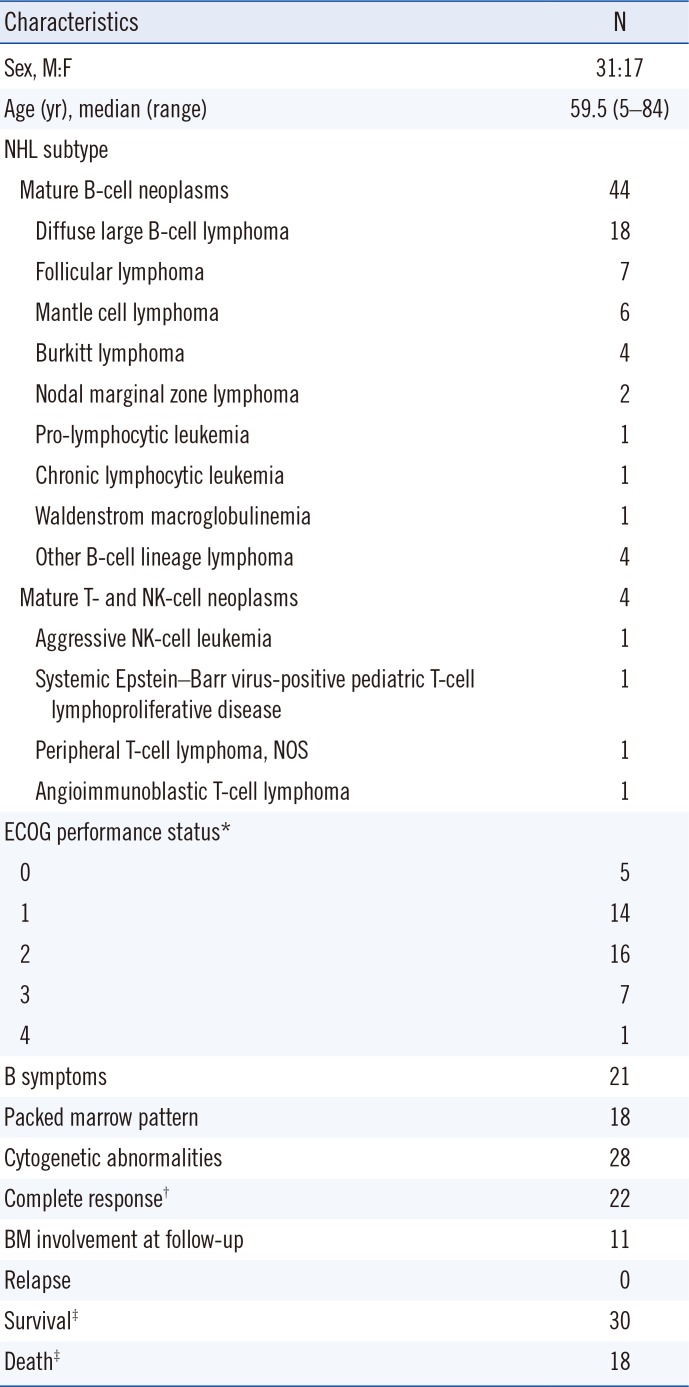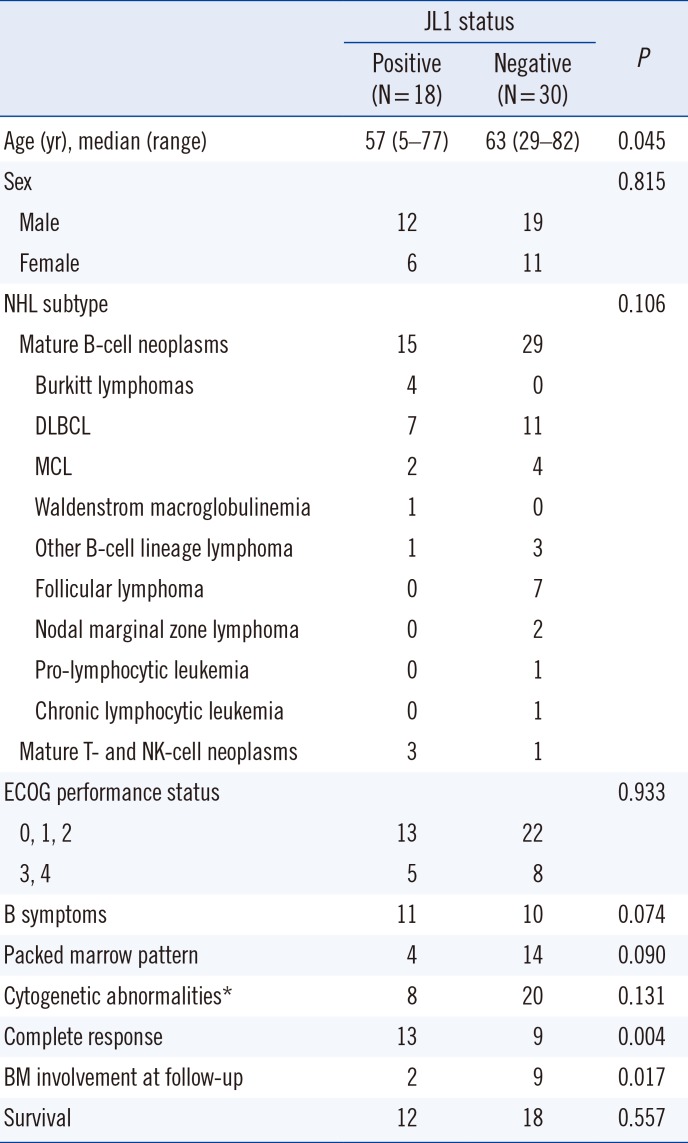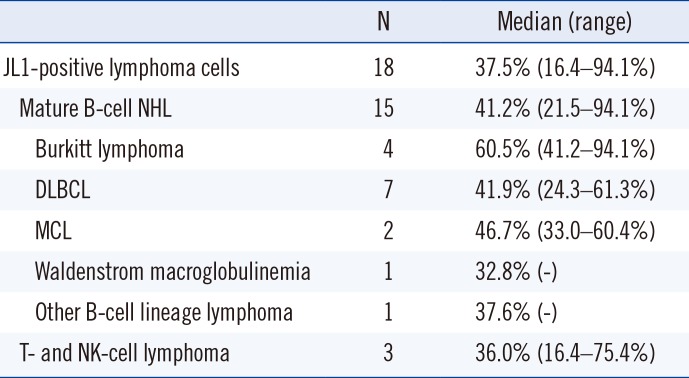1. Park CS, Park SH. Diagnostic usefulness of monoclonal antibody for T lymphoblastic lymphoma/acute lymphoblastic leukemia-specific JL1 antigen in paraffin embedded tissue. Korean J Pathol Trans Med. 1999; 33:1033–1038.
2. Shin YK, Choi EY, Kim SH, Chung J, Chung DH, Park WS, et al. Expression of leukemia-associated antigen, JL1, in bone marrow and thymus. Am J Pathol. 2001; 158:1473–1480. PMID:
11290565.
3. Park SH, Bae YM, Kwon HJ, Kim TJ, Kim J, Lee SJ, et al. JL1, a novel differentiation antigen of human cortical thymocyte. J Exp Med. 1993; 178:1447–1451. PMID:
8376947.
4. Chung JK, So Y, Hong MK, Choi SR, Jeong JM, Lee DS, et al.
In vitro and
in vivo properties of murine monoclonal antibody for a novel immature thymocyte-differentiated antigen, JL1. Nucl Med Biol. 1997; 24:433–437. PMID:
9290079.
5. Park WS, Bae YM, Chung DH, Kim TJ, Choi EY, Chung JK, et al. A cell surface molecule, JL1; a specific target for diagnosis and treatment of leukemias. Leukemia. 1998; 12:1583–1590. PMID:
9766503.
6. Kim S, Hong JW, Cho WD, Moon YR, Yoon SS, Kim MY, et al. Characterization of two novel mAbs recognizing different epitopes on CD43. Immune Netw. 2014; 14:164–170. PMID:
24999313.
7. Kim TJ, Park SH. Immunotherapeutic potential of JL1, a thymocyte surface protein, for leukemia. J Korean Med Sci. 1998; 13:455–458. PMID:
9811172.
8. Chung J, Park S, Kim D, Rhim J, Kim I, Choi I, et al. Identification of antigenic peptide recognized by the anti-JL1 leukemia-specific monoclonal antibody from combinatorial peptide phage display libraries. J Cancer Res Clin Oncol. 2002; 128:641–649. PMID:
12474050.
9. Park YS, Park SH, Park SJ, Kim Y, Jang KT, Ko YH, et al. Expression of JL1 is an effective adjunctive marker of leukemia cutis. Arch Pathol Lab Med. 2010; 134:95–102. PMID:
20073611.
10. Shin YK, Choi YL, Choi EY, Kim MK, Kook MC, Chung J, et al. Targeted cytotoxic effect of anti-JL1 immunotoxin against a human leukemic cell line and its clinical implications. Cancer Immunol Immunother. 2003; 52:506–512. PMID:
12768327.
11. Hwang I, Go H, Jeon YK, Ko YH, Yoon DH, Suh C, et al. Expression of JL1 in Burkitt lymphoma is associated with improved overall survival. Virchows Arch. 2011; 459:353–359. PMID:
21814778.
12. Swerdlow SH, Campo E, Pileri SA, Harris NL, Stein H, Siebert R, et al. The 2016 revision of the World Health Organization classification of lymphoid neoplasms. Blood. 2016; 127:2375–2390. PMID:
26980727.
13. Oken MM, Creech RH, Tormey DC, Horton J, Davis TE, McFadden ET, et al. Toxicity and response criteria of the Eastern Cooperative Oncology Group. Am J Clin Oncol. 1982; 5:649–655. PMID:
7165009.
14. Dunleavy K, Pittaluga S, Maeda LS, Advani R, Chen CC, Hessler J, et al. Dose-adjusted EPOCH-rituximab therapy in primary mediastinal B-cell lymphoma. N Engl J Med. 2013; 368:1408–1416. PMID:
23574119.
15. Freedman AS, Jacobson CA, Mauch P, Aster JC. Non-Hodgkin's lymphoma. In : DeVita VT, Lawrence TSR, editors. DeVita, Hellman, and Rosenberg's cancer: principles and practice of oncology. 10th ed. Philadelphia, PA: Lippincott Williams & Wilkins;2015. p. 1552–1587.
16. Zelenetz AD, Gordon LI, Wierda WG, Abramson JS, Advani RH, Andreadis CB, et al. Non-Hodgkin's lymphomas, version 4.2014. J Natl Compr Canc Netw. 2014; 12:1282–1303. PMID:
25190696.
17. Horwitz SM, Zelenetz AD, Gordon LI, Wierda WG, Abramson JS, Advani RH, et al. NCCN Guidelines Insights: Non-Hodgkin's Lymphomas, Version 3.2016. J Natl Compr Canc Netw. 2016; 14:1067–1079. PMID:
27587620.
18. El-Sayed AM, El-Borai MH, Bahnassy AA, El-Gerzawi SM. Flow cytometric immunophenotyping (FCI) of lymphoma: correlation with histopathology and immunohistochemistry. Diagn Pathol. 2008; 3:43. PMID:
18986555.
19. Gruss HJ, Herrmann F. CD30 ligand, a member of the TNF ligand superfamily, with growth and activation control CD30+ lymphoid and lymphoma cells. Leuk Lymphoma. 1996; 20:397–409. PMID:
8833395.
20. You E, Kim S, Park CJ, Jang S, Cho YU, Yoon CH, et al. JL1 antigen expression of leukemic cells in childhood acute leukemia. Haematologica. 2017; 102:353.
21. Park HS, Lee JH, Lee JH, Kim DY, Choi EJ, Hur EH, et al. Expression of JL1 antigen in acute leukemia and myelodysplastic syndrome. Blood. 2015; 126:3826.
22. Patte C, Auperin A, Michon J, Behrendt H, Leverger G, Frappaz D, et al. The Société Française d'Oncologie Pédiatrique LMB89 protocol: highly effective multiagent chemotherapy tailored to the tumor burden and initial response in 561 unselected children with B-cell lymphomas and L3 leukemia. Blood. 2001; 97:3370–3379. PMID:
11369626.
23. Zhao X, Pogue S, Lin J, Bi M, Wilson Dand Hsi ED. JL1 is a cell surface molecule of acute leukemia blasts: potential for targeted immunotherapy. Cancer Res. 2012; 72:2525.
24. Lee GK, Jung KC, Park WS, Kook MC, Park CS, Sohn HW, et al. LFA-1- and ICAM-1-dependent homotypic aggregation of human thymocytes induced by JL1 engagement. Mol Cells. 1999; 9:662–667. PMID:
10672935.








 PDF
PDF ePub
ePub Citation
Citation Print
Print



 XML Download
XML Download